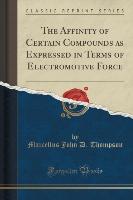- Start
- The Affinity of Certain Compounds as Expressed in Terms of Electromotive Force (Classic Reprint)
The Affinity of Certain Compounds as Expressed in Terms of Electromotive Force (Classic Reprint)
Angebote / Angebote:
Excerpt from The Affinity of Certain Compounds as Expressed in Terms of Electromotive Force
The investigations narrated in the following paper were undertaken at the suggestion of Professor J. W. Langley, and throughout the work I have enjoyed the benefit of his counsel.
The relation of electrical to chemical forces has been a favorite subject of study with chemists and physicists for a long time, ever with those who did not believe in the identity of nature in these two forms of energy.
As late as April 5, 1881, Prof. Helmholtz in his Faraday Lecture advocates the doctrine that these forces are fundamentally identical. After discussing Faraday's law of definite electrolytic action and its results, he says:
"Faraday very often recurs to this to express his conviction that the forces termed chemical affinity and electricity are one and the same... I think these facts leave no doubt that the very mightiest among chemical forces are of electrical origin."
It will be seen even in the following pages that chemical forces may be measured and expressed in terms of electrical measurement, without any computations or conversions whatever. This fact certainly does not prove the identity of the two forces, but it is an interesting fact and one not to be overlooked in making up one's mind on the subject.
This attempt to get some numerical data as to the relative strength of attractions in chemical affinities is not a late effort only with workers in physical science.
Tidy enumerates six methods that have been employed by different investigators, and which I transcribe, giving the name of one or more of the principal experimenters by each method.
I. Affinity measured by reference to the specific gravity of bodies. (La Place and others.)
II. Affinity measured by the force of adhesion. (Guyton Morreau.)
III. Affinity measured by the amount of force required to effect the decomposition of a compound. The decomposition was effected in this case, first - by heat, secondly - by a superior affinity.
About the Publisher
Forgotten Books publishes hundreds of thousands of rare and classic books. Find more at www.forgottenbooks.com
This book is a reproduction of an important historical work. Forgotten Books uses state-of-the-art technology to digitally reconstruct the work, preserving the original format whilst repairing imperfections present in the aged copy. In rare cases, an imperfection in the original, such as a blemish or missing page, may be replicated in our edition. We do, however, repair the vast majority of imperfections successfully, any imperfections that remain are intentionally left to preserve the state of such historical works.
Folgt in ca. 5 Arbeitstagen
